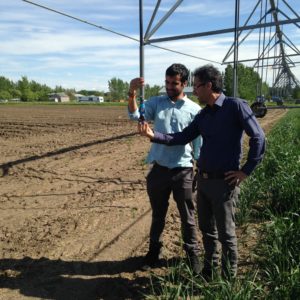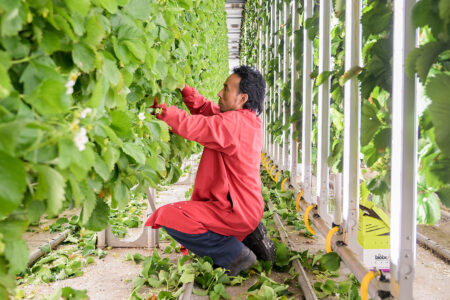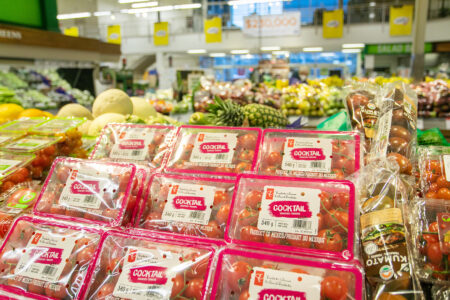
Canadian agricultural producers are innovators. Between 2011 and 2013, almost half of agricultural producers adopted at least one new or significantly improved product, process or practice. From environmental farm plans, where farmers identify environmental conditions of their farms and farming practices and select measures to improve them, to nutrient management legislation and land and water stewardship, producers are employing best practices in management to enhance environmental sustainability and protect air, land and water quality. And they have recognized the need to engage with other stakeholders such as the forestry, fisheries, and waterfowl and wildlife sectors.
Research in plant and animal genomics is leading to higher productivity and less degradation of natural resources, resulting in greater protection of biodiversity as well as native above- and below-ground ecological species. For example, through innovations in crop science, we have preserved and protected over 14 million hectares (the acreage of cultivated land in Saskatchewan) of forest, native grasslands, and wetlands. Farm practices that conserve biodiversity also minimize the invasion of harmful species such as fungi, weeds, pests and diseases.
Canada has been a leader in agricultural water management, specifically irrigation and drainage practices. The government of Alberta — the province with the largest area of irrigated farm land — together with its farmers, has been investing in infrastructure improvements and more efficient on-farm irrigation technologies. Improvements in canal lining, pressurized buried pipelines and pumping stations, and low pressure, low-energy, precision irrigation applicators have reduced water waste. Irrigation today uses 30 percent less water than it did 25 years ago and produces much higher-yielding cereals and forages, and oilseeds. This has enabled more water to go into aquatic wildlife, fisheries and waterfowl habitats. It also allows water resources to be allocated to other industrial sectors and municipalities.

In Ontario, Quebec, and parts of Manitoba and the Maritimes, subsurface tile drainage (perforated plastic pipes buried below the ground) enables producers to grow higher value field crops. These crops also make better animal feed, which has resulted in expansion of the dairy, poultry and pork industries, and higher incomes for those farmers. The practice also reduces soil erosion from farm-fields, and flood flows from agricultural watersheds. Grassed waterways and planted buffer strips on the banks of rivers and lakes, mixed land use and integrated watershed management all improve soil and water quality.
With the aid of environmental farm plans, agricultural producers are implementing measures to reduce agro-chemical pollution of rivers, creeks, lakes and groundwater. These measures include avoiding monoculture, using crop rotations, planting cover crops to use up excess nitrogen and reduce soil erosion, and employing no-till and conservation tillage practices. Management of the underground water table through tile drainage reduces the amount of nitrogen and phosphorus in subsurface drainage flows.
In the dairy industry, with environmental plans as well as improvements in genetics and nutrition, producers use 65 percent less water and 90 percent less land to produce 1 litre of milk than they did 70 years ago. There have also been reductions in land and water use in intensive beef, pork and poultry operations.
Across the agricultural sector there is commitment to reducing greenhouse gas emissions, lowering carbon inputs, and increasing carbon sequestration. No-till systems reduce CO2 emissions, and improved fertilizer and manure management technologies reduce emissions of nitrous oxide. New molecular plant breeding techniques will enable the development of crop varieties that can better withstand drought and use less soil moisture, sequester larger amounts of carbon in the soil to reduce CO2 emissions.
Advanced digital technologies in precision agriculture and precision irrigation will also play an important role in improving environmental and economic sustainability, as well as the biosecurity of the agri-food industry. Eco-health sensors will rapidly detect plant and animal diseases before food products reach the consumer. Environmental sensors measure soil and water quality, allowing pollution control technologies to be deployed on a real-time basis.
Wireless sensor networks use GIS and GPS to collect weather, soil and crop data to precisely determine fertilizer applications, pest and disease infestations, and irrigation requirements. With large data analytical tools, microprocessors and precision controllers, fertilizers and water can be applied precisely in spatial management zones, using variable rate applicators.
Surveillance and monitoring tools such as unmanned aerial systems using drones and remotely sensed images will take environmental farm plans to the next levels of innovation. The agriculture of the not-too-distant future will rely on digital agriculture platforms consisting of wireless sensor networks, crop yield maps, GIS maps of land use and water resources, and analytical data mining tools.
It is expected, with new digital platforms and increasing emphasis on precision agriculture, producers will make use of advanced tools and technologies to further increase profitability and also brand Canada’s agri-food system as among the environmentally safest and cleanest in the world. Canada was already the world’s fifth-largest exporter of agriculture and agri-food products, after the European Union, the United States, Brazil and China, in 2013. This recognition and branding will take the concerted efforts of the federal and provincial governments, working together with agricultural producer organizations like the Canadian Federation of Agriculture and its member producers.
Moreover, to conquer the challenges of food insecurity and malnutrition, global food production will need to at least double over the next 25 years. For Canada to do its part, continuing innovation and adoption of new technologies in the agricultural sector will be crucial.
This article is part of the Canadian Agriculture at the Cutting Edge special feature.
Photo: Low pressure, low energy, center pivot irrigation that conserves water and energy. Lethbridge, Alberta, 2014. Photo: Chandra Madramootoo.
Do you have something to say about the article you just read? Be part of the Policy Options discussion, and send in your own submission. Here is a link on how to do it. | Souhaitez-vous réagir à cet article ? Joignez-vous aux débats d’Options politiques et soumettez-nous votre texte en suivant ces directives.









